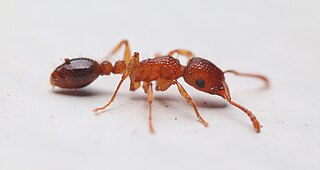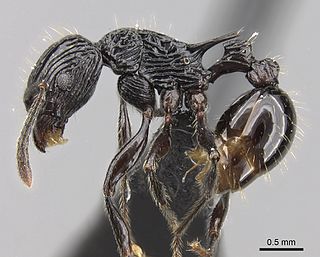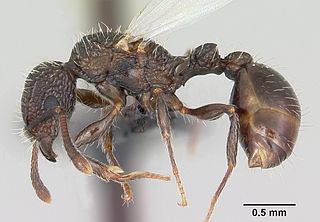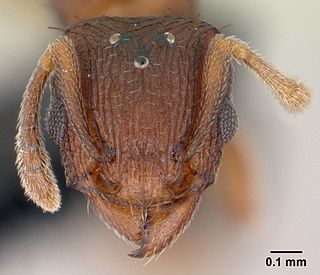
Tetramorium atratulum is a rare workerless socially parasitic ant from the Palaearctic region, which has even been introduced together with its host in North America. This extreme inquiline is represented only by female and pupoid type male individuals, whose morphology and anatomy indicate a highly specialized level of parasitism. The body of males is depigmentated, the cuticle is thin, the petiole and postpetiole are widely connected, and degenerate mandibles, palps, and antennae are observed. Female wing venation is reduced and the occipital region is narrowed. Mature females are typically physogastric and found in queenless host nests.

Tetramorium immigrans—also known as the immigrant pavement ant, pavement ant, and the sugar ant in parts of North America—is an ant native to Europe, which also occurs as an introduced pest in North America. Its common name comes from the fact that colonies in North America usually make their nests under pavement. This is one of the most commonly seen ants in North America, being well adapted to urban and suburban habitats. It is distinguished by one pair of spines on the back, two nodes on the petiole, and grooves on the head and thorax.
Barry Bolton is an English myrmecologist, an expert on the classification, systematics, and taxonomy of ants, who long worked at the Natural History Museum, London. He is known especially for monographs on African and Asian ants, and for encyclopaedic global works, including the Identification Guide to Ant Genera (1994), A New General Catalogue of Ants of the World, Synopsis and Classification of Formicidae (2003), and Bolton's Catalogue of Ants of the World: 1758-2005 (2007). Now retired, Bolton is a Fellow of the Royal Entomological Society and Myrmecologist, Biodiversity Division, Department of Entomology, Natural History Museum, London.

Tetramorium inquilinum is an ectoparasitic ant found in Europe. It was discovered by Swiss myrmecologist Heinrich Kutter. The species is unusual for lacking a worker caste, the queens and males living entirely off the care of the pavement ant. It has been called "the 'ultimate' parasitic ant" by myrmecologists Edward O. Wilson and Bert Hölldobler.

Tetramorium is a genus of ants in the subfamily Myrmicinae that includes more than 520 species. These ants are also known as pavement ants.

Tetramorium caespitum, also known as the pavement ant, is a species of ant in the family Formicidae.

Tetramorium insolens is a species of ant in the genus Tetramorium. It is a medium-sized orange ant that is mainly seen on vegetation, has a monomorphic work caste with 12-segmented antennae, three-segmented antennal club, short antennal scapes that do not surpass the posterior margin of the head, a gradually sloped mesosoma, and strong propodeal spines. It has two waist segments and a gaster with a stinger.

Tetramorium bicarinatum, is a species of ant of the family Formicidae in the order Hymenoptera that originated in South East Asia.

Tetramorium nazgul is a species of Myrmicine ant native to Analalava, Ambohijanahary, and the Zombitse-Vohibasia National Park, Madagascar. The species is characterized by long, thin, propodeal spines. Its body is covered in a multitude of long hairs. General coloration is dark brown or black, with lighter coloration on the legs. The species is commonly found in leaf litter in tropical dry forests and montane rainforests, typically around elevations of 700 to 1,100 meters. It was named after the Nazgûl from J. R. R. Tolkien's The Lord of the Rings.

Tetramorium smaug is a species of myrmicine ant native to Ambatovy, Amber Mountain National Park, and Ivohibe in Madagascar. It was found in montane rainforests around elevations of 900–1,300 metres (3,000–4,300 ft). It is believed to live in vegetation as opposed to on the forest floor. Coloration is dark brown or black. The head and mesosoma have rough surfaces while the gaster is smooth. The head has a large number of hairs, but the amount of hair decreases on each segment posteriorly. The species has long propodeal spines with a broad base. It was named after the dragon Smaug from J. R. R. Tolkien's novel The Hobbit.

Tetramorium pacificum, is a species of ant in the subfamily Myrmicinae. It is found in many countries.
Tetramorium pilosum, is a species of ant in the subfamily Myrmicinae. It is found in Sri Lanka, and China.

Tetramorium simillimum, is a species of ant in the subfamily Myrmicinae. It is a small pale colored widespread species that can be found in almost all the continents.

Tetramorium tonganum is a species of ant in the subfamily Myrmicinae. It is found in Australasian, Indo-Australian, Oriental, and Palaearctic regional countries.
Tetramorium tortuosum, is a species of ant in the subfamily Myrmicinae. It is found in Philippine, India, and Sri Lanka.
Tetramorium transversarium, is a species of ant in the subfamily Myrmicinae. It is found in Sri Lanka.
Tetramorium yerburyi is a species of ant in the subfamily Myrmicinae. It is found in Sri Lanka and China.

Tetramorium hispidum is a species of ant in the subfamily Myrmicinae. Tetramorium hispidum differs from similar ants in the Myrmicinae subfamily by the structure surrounding the ant's antennal insertions. Short, stubble-like hairs exist on the pronotum and frontal carinae. The antenna of Tetramorium hispidum contains 11 segments.











